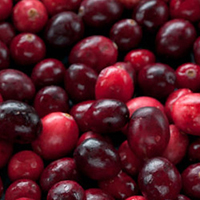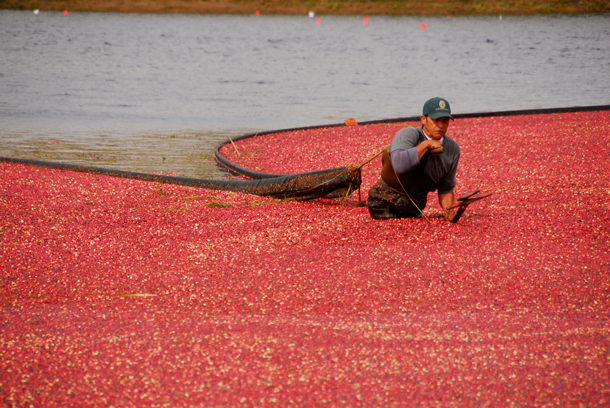Cranberries Take Center Stage
Air Date: Week of November 29, 2019

Fresh cranberries must be dry-harvested, which happens before the wet harvest. (Photo: Pen Waggener, Flickr CC BY 2.0)
For some, it wouldn’t be Thanksgiving without the cranberry sauce. Living on Earth’s Emily Taylor and Dennis Foley bring us this audio postcard featuring Leo Cakounes, a cranberry farmer on Cape Cod, and the voices of cranberry enthusiasts.
Transcript
CURWOOD: As we leave the end of the harvest season and head towards the winter solstice, we take a look at a culinary icon, the cranberry. The Cape Cod region of Massachusetts near Plymouth where the Pilgrims stepped ashore back in 1620 is famous for cranberries, though these days Wisconsin is the state that by far grows the most. Still, Living on Earth’s Emily Taylor and Dennis Foley headed to Cape Cod for this story.
CAKOUNES: My name is Leo Cakounes and I run Cape Farm Supply and Cranberry company.
[MUSIC: Sue Keller “Cranberry Stomp” from ‘Ol’ Muddy: Riverboat Ragtime-Era Piano Sounds’ (HVR - 2003)]
CAKOUNES: Naturally what I think of when I hear the word cranberry is my mortgage payment because we basically that’s what we do for a living is grow cranberries.
MAN: Thanksgiving time so cook them up for turkey.
WOMAN: Decoration with cranberries. I decorate during Christmas time with cranberries myself.
MAN: I suppose cranberry sauce. Having Thanksgiving dinner is definitely the theme.
CAKOUNES: There’s a lot of nostalgia with cranberries, associated with Thanksgiving and that’s understandable but for us it’s a crop that we grow for the purpose of making a living.
MAN: Well, I used to go wild cranberry picking on the Cape with my dad. He’d always take me up on the dunes and show me all the hotspots.
WOMAN: Umm fifth grade. I don’t know, I think I had a dream about a bog. I don’t know. It was kind of weird, but fifth grade.
GIRL: When I think of cranberries I think of coyotes because on Cape Cod there’s tons of cranberry bogs and around them thousands of coyotes live there.
MAN: Since I was a child. I think I was fascinated the first time I saw a cranberry bog.
MAN: The bogs and uh Cape Cod.
CAKOUNES: The harvesting process of cranberries is probably the most interesting process because that’s the time of year most people want to come and see a cranberry bog.
WOMAN: (singing) Did you ever go to the cranberry bogs? Some of the houses are hewed out of logs. The walls are boards that are sawed out of pine. That grow in this country called cranberry mine.
CAKOUNES: There’s two basic kinds of harvesting. There’s the dry harvest. The dry harvest is done first, usually mid September. It’s done when the bog has to be completely dry that means no dew or anything on it. The dry harvesting produces what’s called the fresh fruit. Which is the large cranberries that you buy in the store that the consumer ends up buying, the actual cranberry itself.
WOMAN: He eats them plain, right out of the box. He and his sister both love to eat the cranberries plain.
MAN: I actually eat them plain a lot. I remember going to the museum and seeing them bounce down the little stairway for grating. We’d just pop them in our mouth.
WOMAN: I feel very puckered up and I feel like I’m going to eat something sour. I’m not interested at all…. (laughs)
MAN: The first time I had real cranberry sauce made with whole cranberries I was blown away it was marvelous stuff.

A cranberry grower wet-harvesting cranberries in a bog. (Photo: Massachusetts Office of Travel & Tourism, Flickr CC BY-ND 2.0)
CAKOUNES: The second kind of harvest which is probably most familiar to people is called the wet harvest. And we drive a machine out on the bog which beats the berries off the vine and then coral them with either boards or a cranberry barrier. And then those berries are pumped or loaded into an open truck with a conveyor and then they’re shipped to the supplier. And they’re actually called processed fruit. Those berries become your concentrate for drinks. They become your cranberry sauce.
MAN: For years I thought cranberry sauce was the stuff shaped like a can.
WOMAN: When I was a kid the only cranberries we ate were out of a can. But my mom would just put it on the plate whole in this gelatinous mass, you know. And she’d open up one end and it would just ooze out the other end and be like slurping sounds.
MAN: Canned cranberry sauce is almost never good.
WOMAN: The stuff in a can. You just sort of squish it out of the can and it sits there and giggles on the plate.
MAN: Slice it.
WOMAN: That’s right and you slice it, you can’t even serve it with a spoon.
CAKOUNES: The market for fresh fruit hasn’t really increased that much. There are still some people out there who are still dedicated to buy fresh cranberries and serve them on their Thanksgiving table and we think that’s wonderful. But we are really working hard producing new products. Hoping we can get into the candy market and the cereal market which will pretty much help us year round as opposed to waiting for one Thanksgiving dinner to pay our bills.
CURWOOD: Our cranberry audio postcard was produced by Emily Taylor and Dennis Foley.
Links
Living on Earth wants to hear from you!
Living on Earth
62 Calef Highway, Suite 212
Lee, NH 03861
Telephone: 617-287-4121
E-mail: comments@loe.org
Newsletter [Click here]
Donate to Living on Earth!
Living on Earth is an independent media program and relies entirely on contributions from listeners and institutions supporting public service. Please donate now to preserve an independent environmental voice.
NewsletterLiving on Earth offers a weekly delivery of the show's rundown to your mailbox. Sign up for our newsletter today!
 Sailors For The Sea: Be the change you want to sea.
Sailors For The Sea: Be the change you want to sea.
 The Grantham Foundation for the Protection of the Environment: Committed to protecting and improving the health of the global environment.
The Grantham Foundation for the Protection of the Environment: Committed to protecting and improving the health of the global environment.
 Contribute to Living on Earth and receive, as our gift to you, an archival print of one of Mark Seth Lender's extraordinary wildlife photographs. Follow the link to see Mark's current collection of photographs.
Contribute to Living on Earth and receive, as our gift to you, an archival print of one of Mark Seth Lender's extraordinary wildlife photographs. Follow the link to see Mark's current collection of photographs.
 Buy a signed copy of Mark Seth Lender's book Smeagull the Seagull & support Living on Earth
Buy a signed copy of Mark Seth Lender's book Smeagull the Seagull & support Living on Earth

